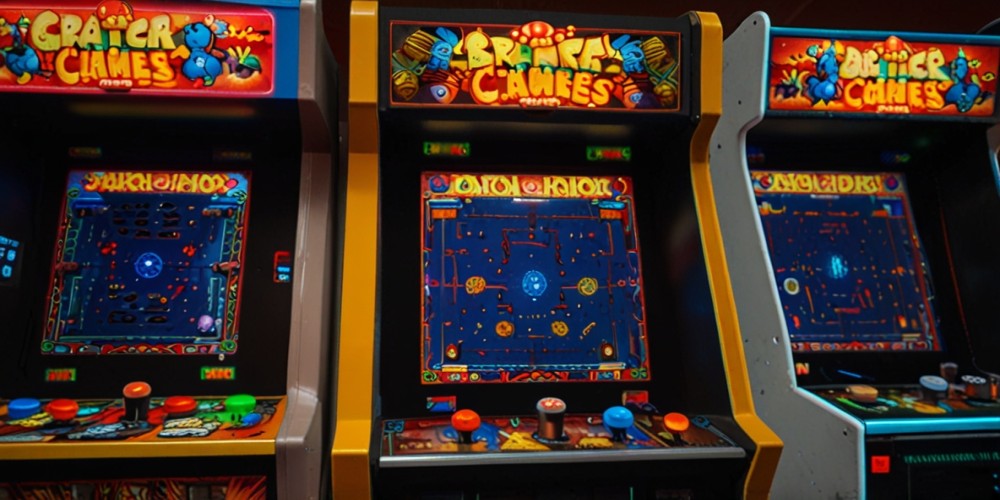Arcade Revolution: How Coin-Op Machines Built the Gaming Industry
Jul-27-2024

When you think about the origins of gaming, the first images that might come to mind are the sprawling digital landscapes of today’s consoles or the sleek designs of modern handhelds. But before these high-tech marvels took over our lives, there was a time when gaming wasn’t something you could enjoy in the comfort of your home. No, sir. You had to grab a few quarters, head down to the local arcade, and try your luck at the latest coin-operated machines. These bad boys weren’t just a pastime—they were the bedrock of an entire industry.
The Spark that Lit the Fire
The gaming industry as we know it today owes a great deal to the arcade scene. Imagine this: it's the early 1970s, and video games are still a novelty. Home consoles are practically non-existent, and computers are expensive beasts that only a select few can afford. Into this world steps a coin-operated machine called Pong. Developed by Atari, Pong wasn’t the first arcade game, but it was the one that caught fire. It was simple—just two paddles and a ball—but man, it was addictive.
People couldn’t get enough of it. Bars, restaurants, and even laundromats scrambled to get their hands on these machines. And once they did, it wasn’t long before customers lined up to play. Pong wasn’t just a game; it was a social phenomenon. It brought people together, and in the process, it turned a fledgling idea into a booming business. The fire was lit, and soon the entire arcade scene was ablaze.
The Golden Age of Arcades
Fast forward to the late 1970s and early 1980s, and arcades were on every corner. The industry had exploded, with companies like Namco, Taito, and Sega leading the charge. The variety of games was staggering, and each one brought something new to the table. You had Space Invaders, where players fended off wave after wave of alien attackers. Then came Pac-Man, with its iconic maze-chomping hero who became a cultural icon in his own right.
But it wasn’t just about the games themselves; it was the experience. Walking into an arcade was like stepping into another world. The lights, the sounds, the smell of freshly made popcorn—it was an assault on the senses in the best possible way. You could lose yourself in there for hours, feeding the machine one quarter after another as you tried to beat your last high score. It was more than just entertainment; it was an obsession.
And let's not forget the competitive spirit that arcades fostered. Back in the day, earning a high score on a game wasn’t just a personal victory—it was a badge of honor. Your initials at the top of that leaderboard meant something. It meant you were the best, at least until someone came along and knocked you off your perch. In a way, arcades were the original esports arenas, where bragging rights were hard-earned and fiercely defended.
Arcades and the Birth of Gaming Culture
Arcades didn’t just give rise to video games—they also helped create the culture that surrounds gaming to this day. Think about it: where else could you find such a diverse group of people all united by a love of games? Kids, teenagers, adults—everyone had a place in the arcade. It was a melting pot of backgrounds, where the only thing that mattered was your skill at the game. In many ways, it was a great equalizer, where social status and personal history took a back seat to pure, unadulterated fun.
But more than that, arcades were the breeding ground for the language, the customs, and the community that would become the foundation of gaming culture. Terms like "high score," "quarter muncher," and "extra life" became part of the vernacular. Friendships were forged over games of Street Fighter and Mortal Kombat, and rivalries were born on the back of lost matches. The arcade was where gamers learned to love the grind, the thrill of victory, and the agony of defeat. It was where they learned that sometimes, you win some, and sometimes, you lose some—but you always come back for more.
The Decline and Reinvention of the Arcade
As the 1980s gave way to the 1990s, the arcade industry started to falter. Home consoles were becoming more advanced and more accessible, offering the same level of excitement without the need to leave your house. Titles like Super Mario Bros. and The Legend of Zelda brought arcade-quality experiences into living rooms around the world. For many, the convenience of home gaming was too good to pass up.
But even as arcades began to disappear from the mainstream, they didn’t fade away completely. In fact, they found new life in different forms. The rise of retro gaming brought a wave of nostalgia, with many seeking out classic arcade cabinets to relive the golden days. Bars and restaurants began to install arcade machines as a way to attract customers, giving rise to the “barcade” trend. And with the resurgence of interest in competitive gaming, arcades have once again become a place to gather, compete, and celebrate the hobby that started it all.
The Legacy of Coin-Op Machines
So, what’s the legacy of the coin-op machines that built the gaming industry? Well, for starters, they proved that video games could be a profitable business. They showed that people were willing to spend their hard-earned cash on a good game and that the gaming experience was something worth paying for. Without arcades, who knows if the gaming industry would have ever reached the heights it has today?
But beyond the financials, arcades left an indelible mark on gaming culture. They were the birthplace of the competitive spirit that drives esports today. They were where gamers first came together as a community, sharing tips, tricks, and stories. They were where many of us fell in love with gaming in the first place. And for that, we owe the arcade era a debt of gratitude.
In the end, the story of arcades is one of innovation, passion, and community. It’s a story about how a simple idea—putting a game in a public place where anyone could play it—sparked a revolution. It’s a story that every gamer should know, because without those humble coin-op machines, the gaming industry as we know it might never have existed. So the next time you pop a quarter into a machine and hear that familiar jingle, remember: you’re not just playing a game. You’re taking part in a legacy that helped shape an entire industry.







